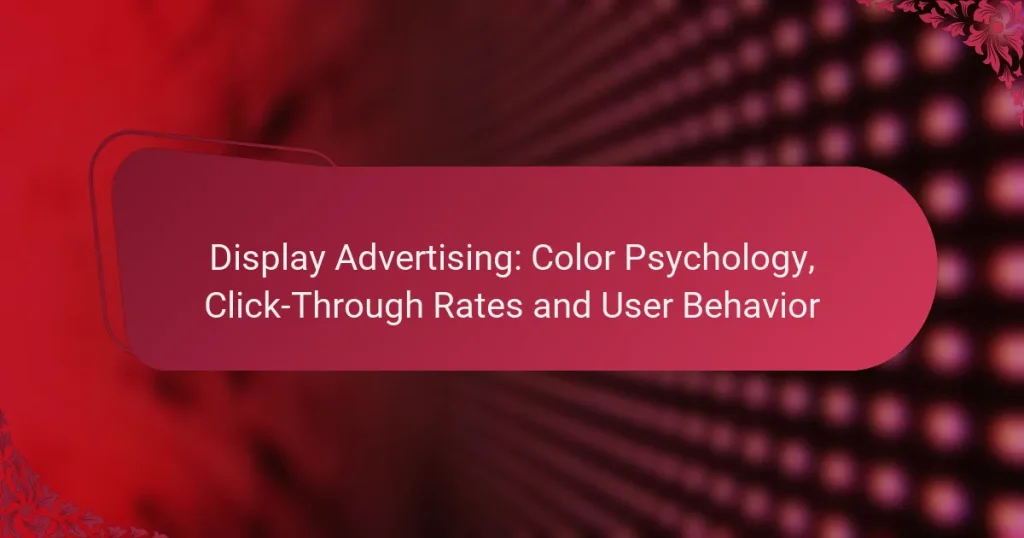Color psychology plays a crucial role in display advertising by shaping viewer emotions and influencing their behaviors, especially in competitive urban environments. By strategically selecting colors that resonate with their target audience, advertisers can significantly enhance click-through rates and overall engagement. Understanding the emotional impact of colors like red and blue allows for the creation of more effective advertisements tailored to user behavior and preferences.

How does color psychology affect display advertising in major cities?
Color psychology significantly impacts display advertising by influencing viewer emotions and behaviors, particularly in major cities where competition is fierce. Advertisers can leverage specific colors to enhance click-through rates and engagement by aligning their color choices with the psychological responses of their target audience.
Color influences emotional responses
Colors evoke distinct emotional responses that can affect consumer behavior. For instance, blue often conveys trust and reliability, making it a popular choice for financial services. In contrast, red can create a sense of urgency, which is beneficial for clearance sales or limited-time offers.
Understanding the emotional impact of colors helps advertisers craft messages that resonate with their audience. In urban environments, where distractions are plentiful, a well-chosen color can capture attention and evoke the desired feelings that lead to action.
Specific colors drive different actions
Different colors can drive specific actions from consumers. For example, green is frequently associated with health and tranquility, making it effective for eco-friendly products. Yellow, on the other hand, can stimulate feelings of happiness and optimism, which can encourage impulse purchases.
When designing display ads, consider using a color palette that aligns with the intended action. For instance, if the goal is to increase sign-ups, using inviting colors like soft blue or green can create a welcoming atmosphere. Conversely, for promotions, bold colors like red or orange can effectively draw attention and prompt immediate responses.

What are the best colors for increasing click-through rates?
The best colors for increasing click-through rates often include red and blue, as they evoke specific emotions and associations that can influence user behavior. Understanding the psychological impact of these colors can help in designing more effective display advertisements.
Red for urgency and excitement
Red is a powerful color that conveys urgency and excitement, making it effective for calls to action. It can create a sense of immediacy, prompting users to click on ads quickly. For instance, using red for buttons like “Buy Now” or “Limited Time Offer” can enhance engagement.
However, overusing red can lead to feelings of aggression or anxiety, which may deter some users. It’s essential to balance red with other colors to maintain a positive user experience. Consider using red accents rather than making it the dominant color in your ad.
Blue for trust and reliability
Blue is often associated with trust, reliability, and professionalism, making it a preferred choice for brands aiming to establish credibility. Many financial institutions and tech companies use blue in their advertising to foster a sense of security among users.
When incorporating blue into display ads, consider using various shades to create depth and interest. Lighter blues can evoke calmness, while darker blues can convey strength. Striking a balance between blue and contrasting colors can enhance visibility and appeal.

How can advertisers leverage user behavior in display ads?
Advertisers can effectively leverage user behavior in display ads by understanding how potential customers interact with content and tailoring their strategies accordingly. This involves analyzing demographic data and past engagement metrics to optimize ad performance and increase click-through rates.
Understanding audience demographics
Understanding audience demographics is crucial for creating targeted display ads that resonate with specific user groups. Factors such as age, gender, location, and interests can significantly influence how users respond to advertisements. For example, younger audiences may prefer vibrant colors and modern designs, while older demographics might respond better to classic styles.
To gather demographic insights, advertisers can use tools like Google Analytics or social media insights. These platforms provide valuable data that can help in segmenting audiences and tailoring messages to meet their preferences. Regularly updating this information ensures that campaigns remain relevant and effective.
Analyzing past engagement metrics
Analyzing past engagement metrics allows advertisers to understand what has worked in previous campaigns and what hasn’t. Key metrics to consider include click-through rates (CTR), conversion rates, and bounce rates. A high CTR indicates that the ad is appealing to users, while a low bounce rate suggests that visitors find the landing page relevant.
Advertisers should regularly review these metrics to identify trends and patterns. For instance, if a particular color scheme or call-to-action consistently yields higher engagement, it may be beneficial to incorporate those elements into future ads. A/B testing different designs and messages can also provide insights into user preferences and improve overall campaign effectiveness.

What frameworks help optimize display advertising strategies?
To optimize display advertising strategies, frameworks like A/B testing and user journey mapping are essential. These methods help identify effective color choices and strategic ad placements that resonate with target audiences.
A/B testing for color effectiveness
A/B testing involves comparing two or more versions of an ad to determine which color scheme yields better performance. By changing colors and measuring click-through rates (CTR), advertisers can identify which hues attract more attention and drive engagement.
For example, a study might test a blue versus a red call-to-action button. If the blue button achieves a significantly higher CTR, it indicates that color choice plays a crucial role in user interaction. Aim for a sample size that provides statistically significant results, typically in the low hundreds to thousands of impressions.
User journey mapping for ad placement
User journey mapping outlines the steps a consumer takes from awareness to conversion, helping advertisers identify optimal ad placements. By understanding where users are in their journey, marketers can strategically position ads to maximize visibility and relevance.
For instance, placing ads on social media platforms during the awareness phase can capture attention, while retargeting ads during the consideration phase can remind users of products they viewed. Ensure that ads align with user intent at each stage to enhance effectiveness and avoid ad fatigue.

What tools can enhance display advertising performance?
Several tools can significantly improve display advertising performance by optimizing targeting, analyzing user behavior, and refining campaign strategies. Utilizing these tools effectively can lead to higher click-through rates and better overall engagement.
Google Ads for targeted campaigns
Google Ads allows advertisers to create highly targeted display campaigns based on user demographics, interests, and online behavior. By leveraging tools like audience targeting and remarketing, businesses can reach potential customers who are more likely to engage with their ads.
To maximize effectiveness, consider setting clear goals for your campaigns and regularly analyzing performance metrics. A/B testing different ad creatives and formats can also help identify which elements resonate best with your audience.
Adobe Analytics for user insights
Adobe Analytics provides deep insights into user behavior, enabling advertisers to understand how audiences interact with their display ads. By tracking metrics such as engagement rates and conversion paths, businesses can make data-driven decisions to enhance their advertising strategies.
Utilize segmentation features to analyze different user groups and tailor your campaigns accordingly. Regularly reviewing these insights can help identify trends and opportunities for improvement, ensuring your advertising efforts remain effective and relevant.

How does seasonal color preference impact advertising?
Seasonal color preferences significantly influence advertising effectiveness by aligning brand messages with consumers’ emotional responses. Understanding these preferences can enhance click-through rates and overall user engagement during specific times of the year.
Warm colors in winter campaigns
Warm colors like red, orange, and yellow evoke feelings of comfort and warmth, making them ideal for winter advertising. These colors can create a sense of coziness that resonates with consumers looking for seasonal products, such as holiday gifts or winter apparel.
When designing winter campaigns, consider using warm colors in promotional materials to attract attention. For example, a red background can enhance the visibility of a sale banner, encouraging users to click through to learn more about the offers available.
Bright colors for summer promotions
Bright colors such as blue, green, and vibrant yellow are effective for summer promotions as they evoke feelings of energy and freshness. These colors can capture the essence of summer activities, appealing to consumers looking for outdoor gear, travel deals, or seasonal events.
Incorporating bright colors into summer advertising can increase engagement. For instance, using a bright blue for a beachwear campaign can evoke a sense of fun and adventure, prompting users to explore the collection further. Aim for a balance of color that reflects the vibrancy of summer while ensuring readability and clarity in your messaging.

What emerging trends are shaping display advertising?
Emerging trends in display advertising are significantly influenced by advancements in technology and changing consumer behaviors. Key developments include the rise of AI-driven personalization and the integration of augmented reality, both of which enhance user engagement and improve click-through rates.
Personalization through AI
AI-driven personalization tailors advertisements to individual user preferences, increasing the relevance of ads shown. By analyzing user data, such as browsing history and demographic information, advertisers can create highly targeted campaigns that resonate with specific audiences.
To implement AI personalization effectively, businesses should focus on collecting quality data and utilizing machine learning algorithms. This approach can lead to higher engagement rates, often resulting in click-through rates that exceed traditional methods by significant margins.
Augmented reality in ad experiences
Augmented reality (AR) enhances display advertising by allowing users to interact with products in a virtual space. This immersive experience can lead to higher engagement, as consumers can visualize how a product fits into their lives before making a purchase.
Brands leveraging AR should ensure that the technology is user-friendly and accessible across devices. For instance, using AR in mobile ads can increase user interaction rates, with studies suggesting that AR ads can boost click-through rates by several times compared to standard display ads.


